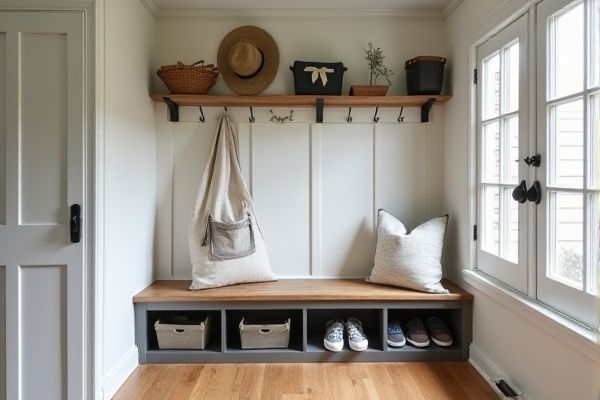
A mudroom bench offers a simple seating area with storage options ideal for putting on shoes, while a hall tree combines seating with hooks and often an overhead shelf for hanging coats and organizing accessories, maximizing entryway functionality. Explore the rest of the article to discover which option best suits Your space and lifestyle needs.
Table of Comparison
| Feature | Mudroom Bench | Hall Tree |
|---|---|---|
| Primary Function | Seating and storage for shoes or small items | Storage, seating, and hanging space for coats and accessories |
| Storage Options | Built-in shelves, cubbies, or drawers | Hooks, shelves, cubbies, and sometimes drawers |
| Size | Compact; fits under a window or in small spaces | Larger; combines seating with vertical storage |
| Placement | Typically placed in mudrooms or entryways | Placed in entryways, foyers, or mudrooms |
| Design Style | Simple, functional bench-focused design | Multifunctional with integrated seating and hanging elements |
| Best For | Homes needing seating and shoe storage | Homes needing comprehensive entryway organization |
Mudroom Bench vs Hall Tree: Key Differences
Mudroom benches primarily offer seating and storage options like shoe racks or cubbies, enhancing organization in entryways without occupying too much space. Hall trees combine bench seating with vertical elements such as coat hooks, shelves, and sometimes mirrors, providing a comprehensive solution for hanging coats, hats, and storing accessories. Choosing between a mudroom bench and a hall tree depends on the need for compact seating and shoe storage versus multifunctional vertical storage and organization.
Space Requirements: Bench or Hall Tree?
Mudroom benches typically require less floor space, making them ideal for smaller entryways, while hall trees occupy more space due to integrated storage features like coat hooks, shelves, and cubbies. Choosing a mudroom bench allows for a compact seating area without overwhelming the room, whereas a hall tree combines seating and vertical storage but demands a larger footprint. Consider room dimensions and storage needs to determine whether the minimalist bench or multifunctional hall tree best maximizes limited space.
Storage Capacity Comparison
Mudroom benches typically offer focused storage through under-seat compartments or built-in cubbies, making them ideal for organizing shoes and small items efficiently. Hall trees, on the other hand, combine seating with vertical storage options like hooks, shelves, and sometimes drawers, providing greater capacity for coats, bags, and accessories in one unit. When maximizing storage capacity, hall trees generally exceed mudroom benches by integrating multiple storage types within a single piece of furniture.
Design Styles and Aesthetics
Mudroom benches often feature minimalist and functional designs that emphasize clean lines and practical storage solutions, blending seamlessly with modern or rustic interiors. Hall trees typically showcase a combination of seating, hooks, and storage, often incorporating ornate or traditional elements that enhance entryway aesthetics with a classic or farmhouse charm. Both options offer varied materials like wood, metal, and wicker, allowing customization to complement specific design themes in residential spaces.
Functionality and Practical Uses
Mudroom benches provide a dedicated seating area for removing shoes and often include storage options like cubbies or shelves for organizing footwear and outdoor gear. Hall trees combine a bench with hooks or racks for hanging coats, hats, and bags, maximizing vertical storage and keeping entranceways tidy. Both pieces enhance entryway functionality, but hall trees offer more comprehensive organization by integrating seating with hanging space.
Best Materials for Mudroom Benches and Hall Trees
Wood and metal are the best materials for mudroom benches and hall trees due to their durability and aesthetic appeal. Solid hardwoods like oak, maple, and walnut offer strong support and can withstand heavy use, while powder-coated steel frames provide a modern look with excellent rust resistance. Your choice should balance style, longevity, and ease of maintenance to ensure the furniture complements your space while handling daily wear.
Installation and Placement Tips
When choosing between a mudroom bench and a hall tree, consider your space and installation needs carefully. Mudroom benches require straightforward placement, often against a wall, with some models needing minimal assembly, making them ideal for compact areas. Hall trees typically involve mounting for stability, combining a bench, hooks, and storage, so selecting a spot near entryways maximizes functionality while ensuring secure installation.
Maintenance and Durability
Mudroom benches, typically made from solid wood or metal, offer greater durability with less frequent maintenance, as they resist wear from heavy use and are easier to clean. Hall trees, often constructed with additional storage features and intricate designs, may require more upkeep to maintain their finish and structural integrity over time. Your choice should consider the balance between low-maintenance durability and the multifunctional appeal of a hall tree.
Cost Analysis: Mudroom Bench vs Hall Tree
A mudroom bench typically costs between $100 and $300, offering a budget-friendly seating solution with basic storage options. Hall trees, combining hooks, benches, and often cabinets, range from $200 to $600 or more, reflecting their multifunctional design and added materials. Your choice depends on whether you prioritize affordability with a mudroom bench or multifunctional storage with a hall tree for your entryway.
Choosing the Right Option for Your Home
Selecting between a mudroom bench and a hall tree depends on your space and storage needs; mudroom benches offer seating with hidden storage, ideal for small entryways, while hall trees combine hooks, benches, and often shelves for hanging coats and organizing shoes in larger areas. Consider how much vertical storage versus seating your home requires to maximize functionality without clutter. Your choice should enhance both the aesthetics and organization of your entryway, ensuring convenience and style.
 homyna.com
homyna.com